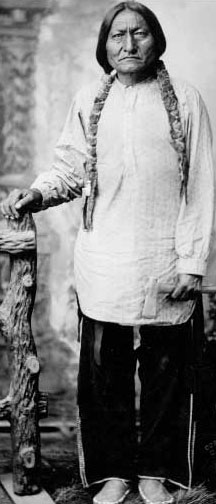|
If he were alive today, Sitting Bull would grace the covers of both Time and People and be a frequent commentator on cable news. He'd be seen on the town with the pretty and powerful while fighting to the death for the plain and powerless; he'd pose for the paparazzi, eat at five-star restaurants and break bread with world leaders. He would make money only to give it all away, living in bare simplicity. He would be a force like no other.
This is the Sitting Bull few people know. This is the man—neither the hard-hewn image emblazoned on t-shirts nor the boor caricatured in the recent HBO twaddle—who we see in John Ferry's captivating documentary, Sitting Bull: A Stone in My Heart. Ferry spent four years of research to develop an oral history, the story of Tatanka-Iyotanka in his own words, recited in earnest authenticity by artist and activist Adam Fortunate Eagle.
Like documentarian Ken Burns at his best, the viewer is yanked head and heart to bear witness as Native America's most famous son talks about growing up on the Northern Plains, the Battle of the Little Big Horn and finally, his complicated views of Euro-American culture. Except for a few lines of dialogue invented for cohesion, it is Sitting Bull's first-person account of his life and times. And what an amazing life and time it was.
"Through this man, we gain an understanding of the whole Native American story—really he's emblematic of all of the Native cultures—not just the Sioux or North American Indians, but those from South America, Central America, Australia—he represents that struggle," Ferry says.
The reason for choosing Sitting Bull as his focus was easy. "Every other film I'd seen him portrayed in, he's either a caricature or sort of in the background and not at all an important individual. The exception is Bury My Heart at Wounded Knee, which I detested. Sitting Bull was misrepresented and was made to look like a not very good person. Sure, he was arrogant and all that, but he wasn't a coward and they made him look like one. That's nonsense."
But colorful he was. A standout leader even at a young age, he used his bravery and wit to defy the encroachment into his ancestral lands. He reveled in the attention from performing in Buffalo Bill's Wild West show, selling his autograph for a dollar or more a pop. He loved fame and developed a appreciation for ice cream and White dancing girls.
When he finally met with the "Great White Father" to explain the plight of his people in the Dakotas, Sitting Bull was insulted by President Cleveland's dismissive demeanor.  This was not the treatment a man of his stature and outsized ego was willing to accept. Similarly, he found it astounding that a culture that calls itself "civilized" abused its children and allowed people to go homeless and hungry on city streets. He used his income to help the urban poor and those struggling back home, keeping none for his personal enrichment. It's clear that despite the allure of celebrity, he remained to his core a Hunkpapa Lakota chief—a devotion that cost him his life in 1890. This was not the treatment a man of his stature and outsized ego was willing to accept. Similarly, he found it astounding that a culture that calls itself "civilized" abused its children and allowed people to go homeless and hungry on city streets. He used his income to help the urban poor and those struggling back home, keeping none for his personal enrichment. It's clear that despite the allure of celebrity, he remained to his core a Hunkpapa Lakota chief—a devotion that cost him his life in 1890.
It is anecdotes like these interspersed with archival photos, graphics and a powerful score by Steve Henry and Cory and Ernie Orosco that leave you wanting to know more. Who was this charismatic and vainglorious leader we see and hear in this film? And, you can't help but wonder…Did he really SAY this stuff?
Yes, says Ferry, who, in addition to his years of research, relied on historians Robert Utley and Dr. Donald Fixico to ensure historical accuracy. Which increases the impact that much more. "I feel like I know him. I developed a tremendous amount of admiration for Sitting Bull's integrity, even when you consider the whole Buffalo Bill episode in his life."
"…But more importantly, I think it's important that viewers understand what went on, the history. I want them to see Sitting Bull as a human being," he continues. "I want people to know more, through his words, about this shameful tragedy that happened by White incursion into Indian lands. Maybe then people will think about Native Americans in a different light."
Maybe then people will think about Native Americans in a different light.
John Ferry's Sitting Bull: A Stone in My Heart succeeds in doing just that. And it's a good bet that this is just what Tatanka-Iyotanka would have wanted most of all.
Sitting Bull: A Stone in My Heart is screening at select film festivals and local PBS stations, with a national television release planned in the near future. It is available for purchase by visiting the official film website: www.sittingbullfilm.com
|
